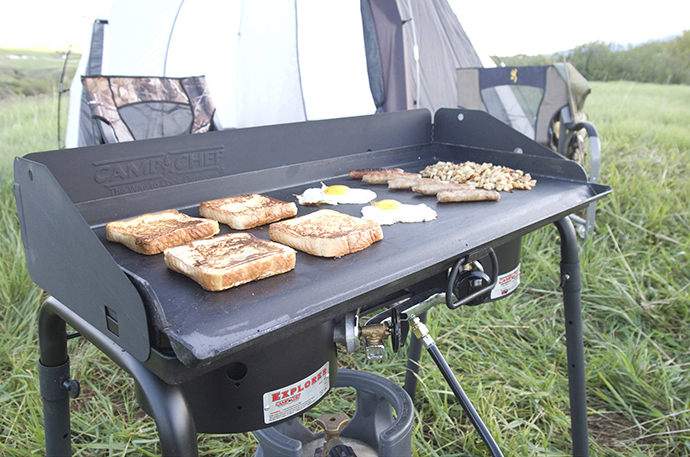
There are lessons that we can learn from our home kitchens when setting up our camp kitchens.
In the 1920s and 1930s, the home kitchen underwent a massive renovation and has, for the most part remained consistent with neatly organized cabinets, counter space, easy-to-clean tiled backsplashes, and optimal layouts to maximize efficiency.
But what about our camp kitchens? Are they efficient? Can we easily access what we need? Do we have adequate work space? Is there a designated place for clean up? Is there a place for cooking with a Dutch oven or a box oven, and a place for starting our charcoal?
According to HGTV, the best kitchen layouts are Galley, L-Shaped, and U-Shaped or Horseshoe.
Galley Kitchen Layout
This efficient, “lean” layout is ideal for smaller spaces and one-cook kitchens. The galley kitchen, also called a walk-through kitchen, is characterized by two walls opposite of each other—or two parallel countertops with a walkway in between them. Galleys make the best use of every square inch of space. You typically see them any where there are tight quarters like airplanes, boats, submarines, motor homes and camper trailers.
L-Shape Kitchen Layout
An L-shaped kitchen solves the problem of maximizing corner space, and it’s a smart design for small and medium sized kitchens. The versatile L-shaped kitchen consists of countertops on two adjoining walls that are perpendicular, forming an L. The “legs” of the L can be as long as you want, though keeping them less than 12 to 15 feet will allow you to efficiently use the space. With an L-shaped layout, you’ll eliminate traffic: The kitchen will not become a thoroughfare because it’s just not logistically possible.
Horseshoe/U-Shaped Kitchen Layout
The horseshoe, or U-shape, kitchen layout has three walls of workspace. Like the L-Shape, this layout eliminates traffic because it is a dead end. Having three walls of workspace allows you to set up multiple workstations and is great for multiple cooks in the kitchen.
I prefer the horseshoe because it maximizes my work space and uses the traditional work triangle, which is efficient. I can set up my chuck box, a large camp stove, my Dutch oven table, and I can have 2 tables for work space with one doubling as a dish washing station. I can use the corners and the space under my tables for my food totes, coolers, general storage, and garbage containers. If you’re using a standard 10×10 canopy shelter, this still leaves a generous amount of space in the middle for maneuvering. It will still be tight, and if you have multiple cooks in the kitchen, you will be bumping butts; however, weather permitting, some folks could work on the outside perimeter of the canopy shelter.
If you’ve got a larger canopy shelter, something along the size of a 10×15 or 10×20, you could add a center island of tables for added work space and it could double as a serving area. Just set out all the food and eating utensils on the island and campers can file in on side, walk around the island to fill their plates, and exit out the other side.
Work Zone Concept
Over the years, the traditional kitchen has evolved into a more practical “work zone” concept and that can work in our camp kitchens as well. I almost always have helpers in my camp kitchen especially on scouting campouts. I’m always grateful when folks volunteer to help out. It lightens the load and makes for good socializing and memory making. And, if an issue arises, you have more heads to brainstorm a solution.
When laying out your kitchen, be mindful of where folks will be standing while they work and make sure everyone has access to equipment, food totes, coolers, and recipes.
Position your work zones to allow enough space for folks tending to pots on the camp stove, prepping ingredients, washing dishes, starting charcoal, or preparing biscuits or a dessert for baking. Folks are usually very understanding and courteous toward each other, but you still want everyone to have a little elbow room. I try to allow about 3 feet of space, which is what I have in my home kitchen between my counters and my small center island. My home kitchen is 12×10, which is just a little bigger than my 10×10 camp kitchen.
So, take a look at your home kitchen or think about the home kitchen you’d like to have. What do you like about it. How can you apply that to your camp kitchen? Take stock of what you got and think about what you need in your camp kitchen. Will it be just you in the kitchen or will you have others in the kitchen with you? What work zones do you think you’ll need? Do you need a place for Dutch ovens? Where will dishes be washed? How much “counter space” do you think you’ll need? And then start figuring out the layout that will work best for you and your sous chefs.
If you like this blog and don’t want to miss a single post, subscribe to Chuck Wagoneer by clicking on the Follow Us button in the upper right corner and follow us on Facebook and Pinterest for the latest updates and more stuff!






















Recent Comments